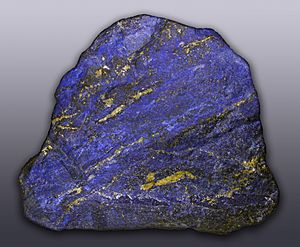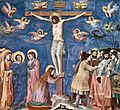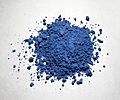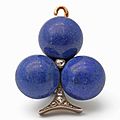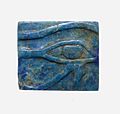Lapis lazuli facts for kids
Quick facts for kids Lapis lazuli |
|
|---|---|
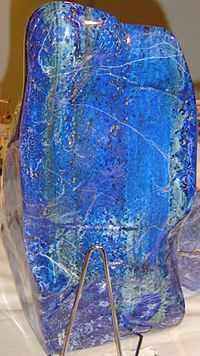
A polished specimen of lapis lazuli.
|
|
| General | |
| Category | Rock |
| Formula (repeating unit) |
mixture of minerals |
| Identification | |
| Color | Blue, mottled with white calcite and brassy pyrite |
| Mohs scale hardness | 5–5.5 |
| Luster | dull |
| Streak | light blue |
| Specific gravity | 2.7–2.9 |
| Refractive index | 1.5 |
| Other characteristics | The variations in composition cause a wide variation in the above values. |
Lapis lazuli is a mineral, and a gemstone. It is formed as a metamorphic rock of the limestone type.
Lapis is famous for its beautiful blue colour: its name means "stone of blue". Lapis Lazuli has been used for many things. Its has been made into beads and used in jewellery since Prehistoric times. It can be carved into statuettes (little sculptures). The major use was as a pigment (colour) in artists' paint. During Medieval and Renaissance times, lapis was ground into powder, and mixed with oil. It was used as the colour for painting the sky, and blue clothes. It can be seen in the fresco paintings of Giotto and the tempera paintings of Fra Angelico.
Lapis lazuli is a metamorphic rock made from several minerals, but mainly Lazurite. Lazurite has been mined for over 6,000 years in Afghanistan. It is also mined at Lake Baikal in Siberia; at Mount Vesuvius in Italy; in Burma; Canada; and the United States.
Afghanistan was the source of lapis for the ancient Egyptian and Mesopotamian civilizations, as well as the Ancient Greeks and Romans. During the height of the Indus Valley civilization about 2000 BC, the Harappan colony now known as Shortugai was established near the lapis mines.
In addition to the Afghan deposits, lapis has been extracted for many years in the Andes (near Ovalle, Chile), the Lake Baikal region of Russia; Siberia; Angola; Argentina; Burma; Pakistan; Canada; India; and in the USA in California and Colorado.
Alternatives
Lapis lazuli is commercially "synthesized" (actually simulated) by a chemical process, using artificial ultramarine and hydrous zinc phosphates. There are also various substitutes for lapis.
- Hurlbut, Cornelius S.; Klein, Cornelis, 1985, Manual of Mineralogy, 20th ed., Wiley, ISBN: 0-471-80580-7
-
This statuette carved in Lapis lazuli was possibly made in India.
Images for kids
-
Ancient Egyptian cult image of Ptah; 945–600 BC; lapis lazuli; height of the figure: 5.2 cm, height of the dais: 0.4 cm; Metropolitan Museum of Art (New York City)
-
Natural ultramarine pigment made from ground lapis lazuli. During the Middle Ages and Renaissance it was the most expensive pigment available (gold being second) and was often reserved for depicting the robes of Angels or the Virgin Mary
-
Sumerian necklace beads; 2600–2500 BC; gold and lapis lazuli; length: 54 cm; Metropolitan Museum of Art (New York City)
-
Ancient Egyptian scarab finger ring; 1850–1750 BC; lapis lazuli scarab set in gold plate and on a gold wire ring lapis-lazuli; diameter: 2.5 cm, the scarab: 1.8 cm; Metropolitan Museum of Art
-
Ancient Egyptian plaque with an Eye of Horus; 664–332 BC; lapis lazuli; length: 1.8 cm, width: 1.6 cm; Metropolitan Museum of Art
-
Large lapis lazuli specimen from Afghanistan's Hindu Kush mountains. National Museum of Natural History (Washington, D.C.)
See also
 In Spanish: Lapislázuli para niños
In Spanish: Lapislázuli para niños


